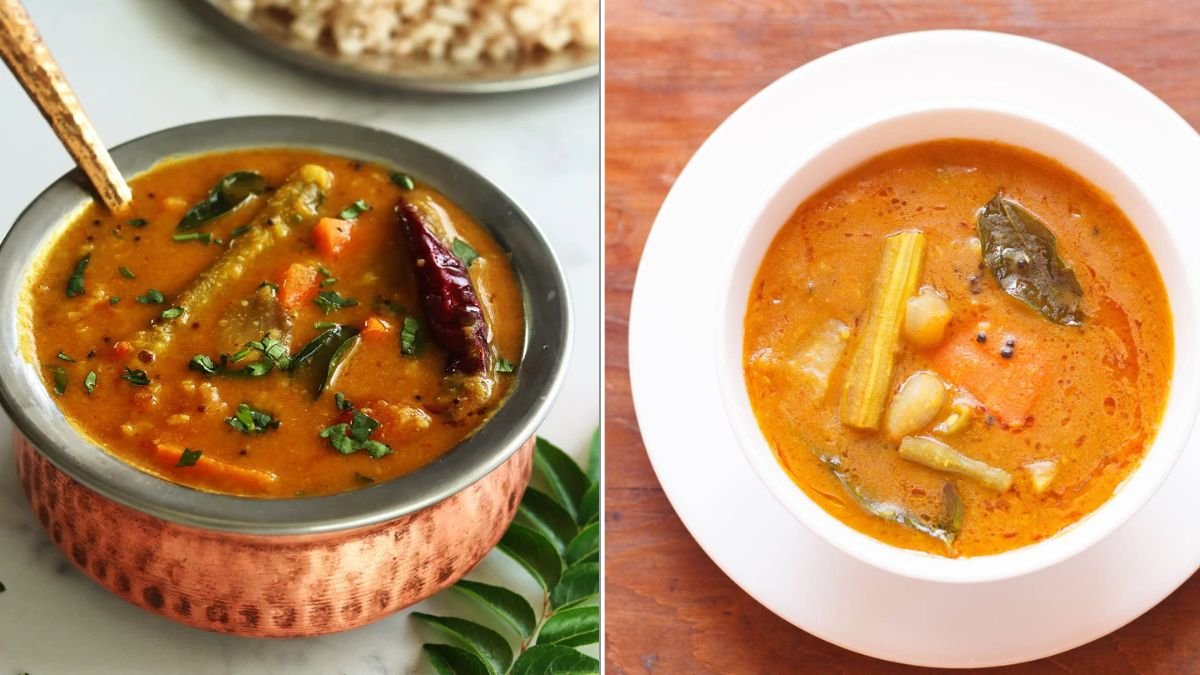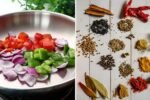Few dishes represent South Indian cuisine as beautifully as Sambar — a hearty, aromatic lentil stew simmered with tamarind, vegetables, and a blend of bold spices. Whether it’s served with fluffy idlis, crispy dosas, or a bowl of steaming rice, Sambar is the soul of South Indian comfort food.
Every household from Tamil Nadu to Kerala has its own version — some thick and tangy, others thin and spicy — but the essence remains the same: a perfect balance of earthy dal, tangy tamarind, and fragrant spices.
In this guide, we’ll take you through six simple yet authentic steps to prepare Sambar the traditional South Indian way — with all the tips, tricks, and regional secrets you need for that perfect flavor.
🥄 Step 1: Gather Your Ingredients
To make a traditional South Indian-style Sambar, you’ll need a combination of basic staples and fresh produce. Most ingredients are easily available in Indian kitchens.
Main Ingredients:
- Toor Dal (Pigeon Pea Lentils) – ½ cup
- Tamarind (Imli) – A lemon-sized ball (or 2 tablespoons of tamarind paste)
- Assorted Vegetables – About 2 cups total. Common choices include:
- Drumstick (moringa pods) – 1, cut into pieces
- Carrot – 1, chopped
- Brinjal (eggplant) – 1 small, diced
- Tomato – 1 large, chopped
- Okra (lady’s finger) – 5–6 pieces (optional)
- Pumpkin – ½ cup, cubed
- Turmeric Powder – ½ teaspoon
- Salt – To taste
For Tempering (Tadka):
- Oil or Ghee – 2 tablespoons
- Mustard Seeds – 1 teaspoon
- Cumin Seeds – ½ teaspoon
- Dry Red Chilies – 2
- Curry Leaves – 10–12 leaves
- Asafoetida (Hing) – A pinch
Spices for Sambar Powder:
You can use store-bought sambar powder or make a quick homemade blend for fresher flavor.
Homemade Sambar Powder (optional):
- Coriander Seeds – 2 tablespoons
- Dried Red Chilies – 4
- Chana Dal (Bengal gram) – 1 tablespoon
- Urad Dal – 1 tablespoon
- Fenugreek Seeds – ¼ teaspoon
- Black Peppercorns – ½ teaspoon
- Cumin Seeds – 1 teaspoon
- Curry Leaves – 8–10
- Grated Coconut (dry) – 2 teaspoons (optional)
Roast these ingredients in a dry pan until fragrant, cool slightly, and grind into a fine powder. This powder will be the soul of your Sambar.
🫘 Step 2: Cook the Toor Dal to Perfection
Sambar starts with perfectly cooked toor dal, which forms its creamy base.
- Rinse ½ cup of toor dal under cold water until the water runs clear.
- Add it to a pressure cooker or pot with 1½ to 2 cups of water, a pinch of turmeric, and a few drops of oil (to prevent frothing).
- Pressure cook for 3–4 whistles or until the dal is soft and mushy.
- Once pressure releases naturally, mash the dal well using a ladle or whisk until smooth.
If you’re cooking in an open pot, simmer for 35–40 minutes, adding water as needed, until the lentils break down completely.
Pro Tip: The smoother the dal, the creamier your Sambar will be. Avoid leaving chunky bits.
🍠 Step 3: Prepare the Tamarind Extract and Vegetables
While the dal cooks, let’s get your tamarind extract and vegetables ready.
- Soak the tamarind in 1 cup of warm water for about 10–15 minutes.
- Squeeze and strain the pulp through your fingers to extract the juice. Discard the fiber and seeds.
- In a medium pot, add your vegetables, 1½ cups of water, a pinch of turmeric, and salt.
- Bring to a gentle boil and cook until the vegetables are tender but not mushy — around 10–12 minutes.
Add the tomatoes last so they don’t disintegrate completely.
Pro Tip: If using okra, sauté it separately in a teaspoon of oil before adding it to the Sambar to prevent it from becoming slimy.
🍅 Step 4: Combine Dal, Vegetables, and Tamarind
Now comes the part where everything comes together beautifully.
- Add the cooked dal to the pot of boiled vegetables.
- Pour in the tamarind extract and stir well.
- Add 2 to 3 teaspoons of sambar powder (adjust based on spice preference).
- Let the mixture come to a gentle simmer.
Allow the Sambar to cook uncovered on low heat for 10–15 minutes, stirring occasionally. The flavors of the dal, tamarind, and spices will begin to meld together, creating that signature South Indian aroma.
Adjust Consistency:
If the Sambar looks too thick, add a little hot water until it reaches a pourable, stew-like texture.
🧄 Step 5: Tempering – The Aromatic Finishing Touch
Tempering (or tadka) is what gives South Indian Sambar its irresistible aroma and final burst of flavor.
How to Temper Sambar:
- Heat 2 tablespoons of oil or ghee in a small pan.
- Add mustard seeds and let them pop.
- Add cumin seeds, dry red chilies, curry leaves, and a pinch of asafoetida (hing).
- Fry for just 20–30 seconds until fragrant — don’t let the spices burn!
- Immediately pour this sizzling tadka over the simmering Sambar and give it a quick stir.
That sound and smell — the sizzle of spices hitting the hot lentil stew — is the moment every South Indian cook waits for. It’s the magic that transforms a simple lentil soup into something divine.
🌿 Step 6: Garnish, Rest, and Serve
Your Sambar is now ready — but before serving, let it rest for 10–15 minutes off the heat. This resting time allows the flavors to deepen and balance beautifully.
Garnish with fresh coriander leaves and serve hot.
Serving Suggestions:
Sambar is incredibly versatile. Here’s how South Indians enjoy it across meals:
- With Idli: A classic breakfast combo — fluffy idlis soaked in hot Sambar and topped with ghee.
- With Dosa: Crisp dosas dipped in Sambar with coconut chutney on the side.
- With Vada: The beloved “Sambar Vada” — deep-fried lentil fritters soaking in spicy lentil soup.
- With Rice: The ultimate comfort meal — Sambar rice with papad, pickle, and curd.
🌶️ Tips for Perfect South Indian Sambar
- Use toor dal: Though other lentils like moong or masoor can be used, authentic Sambar uses toor dal for its nutty flavor and creamy texture.
- Don’t skip tamarind: It’s what gives Sambar its characteristic tang. If you don’t have fresh tamarind, use a good-quality tamarind paste.
- Homemade sambar powder = best flavor. Store-bought is convenient, but homemade blends are fresher and more aromatic.
- Balance is key: The perfect Sambar should have a balance of spicy, tangy, and slightly sweet notes. You can add a pinch of jaggery if your tamarind is very sour.
- Use drumsticks if available: The unique flavor they impart is what makes authentic South Indian Sambar stand out.
- Add ghee at the end: A teaspoon of ghee just before serving enhances the richness and aroma.
🍛 Regional Variations of Sambar
Every state in South India has its own twist on this iconic dish.
- Tamil Nadu Sambar: Tangy and bold, often served with rice; includes small shallots or drumsticks.
- Kerala Sambar: Uses coconut and curry leaves for a rich, earthy flavor.
- Andhra Sambar: Spicier with more red chilies and tamarind.
- Karnataka Sambar: Slightly sweeter and thicker, often with jaggery and coconut.
You can try each version by tweaking the spices and vegetables — every region adds its own personality to the dish.
❤️ Why Homemade Sambar Tastes Better
Store-bought mixes or restaurant versions can’t match the warmth and aroma of homemade Sambar. When you roast your own spices, extract your tamarind fresh, and simmer everything slowly, you create layers of flavor that no instant packet can replicate.
Plus, Sambar is packed with plant-based protein, fiber, and antioxidants, making it one of the healthiest comfort foods in Indian cuisine.
🌟 Final Thoughts
Making South Indian-style Sambar from scratch might seem elaborate, but once you understand the rhythm — cook the dal, boil the veggies, add tamarind and spices, and finish with tadka — it becomes second nature.
In just six simple steps, you can bring the flavors of a traditional South Indian kitchen to your table:
- Gather ingredients
- Cook the dal
- Prepare tamarind and veggies
- Combine everything
- Add tempering
- Rest and serve
The result? A bowl of Sambar that’s spicy, tangy, hearty, and deeply satisfying — perfect for any meal of the day.
So, next time you crave South Indian comfort food, skip the restaurant order. Instead, let your kitchen fill with the warm aroma of roasted spices and simmering tamarind — and serve up a pot of homemade Sambar made the authentic, soulful way.
Few dishes represent South Indian cuisine as beautifully as Sambar — a hearty, aromatic lentil stew simmered with tamarind, vegetables, and a blend of bold spices. Whether it’s served with fluffy idlis, crispy dosas, or a bowl of steaming rice, Sambar is the soul of South Indian comfort food.
Every household from Tamil Nadu to Kerala has its own version — some thick and tangy, others thin and spicy — but the essence remains the same: a perfect balance of earthy dal, tangy tamarind, and fragrant spices.
In this guide, we’ll take you through six simple yet authentic steps to prepare Sambar the traditional South Indian way — with all the tips, tricks, and regional secrets you need for that perfect flavor.
Step 1: Gather Your Ingredients
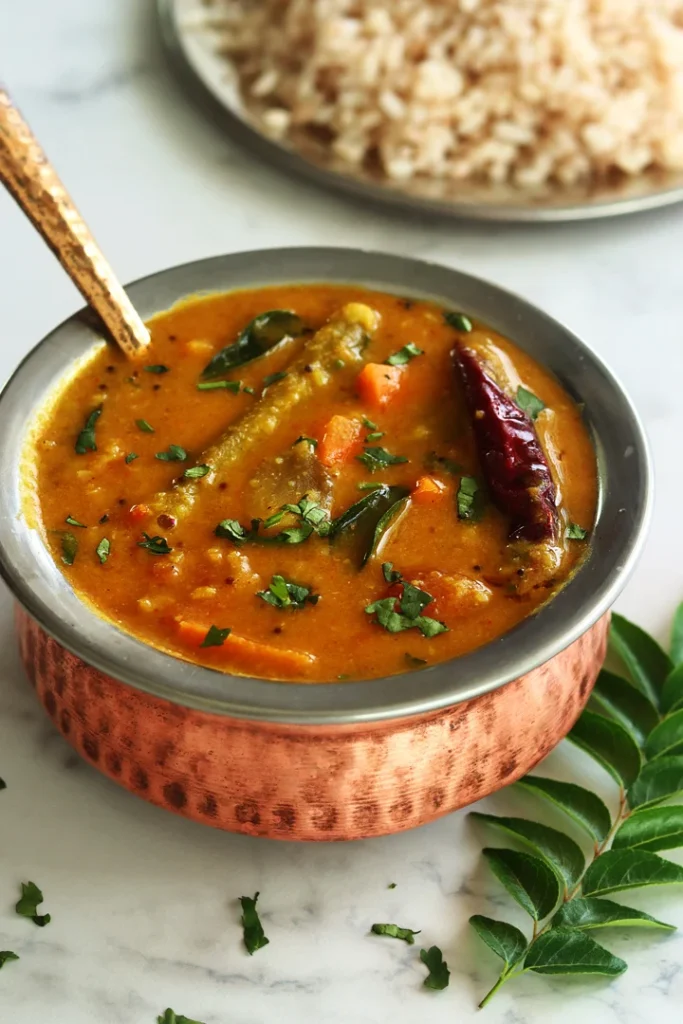
To make a traditional South Indian-style Sambar, you’ll need a combination of basic staples and fresh produce. Most ingredients are easily available in Indian kitchens.
Main Ingredients:
- Toor Dal (Pigeon Pea Lentils) – ½ cup
- Tamarind (Imli) – A lemon-sized ball (or 2 tablespoons of tamarind paste)
- Assorted Vegetables – About 2 cups total. Common choices include:
- Drumstick (moringa pods) – 1, cut into pieces
- Carrot – 1, chopped
- Brinjal (eggplant) – 1 small, diced
- Tomato – 1 large, chopped
- Okra (lady’s finger) – 5–6 pieces (optional)
- Pumpkin – ½ cup, cubed
- Turmeric Powder – ½ teaspoon
- Salt – To taste
For Tempering (Tadka):
- Oil or Ghee – 2 tablespoons
- Mustard Seeds – 1 teaspoon
- Cumin Seeds – ½ teaspoon
- Dry Red Chilies – 2
- Curry Leaves – 10–12 leaves
- Asafoetida (Hing) – A pinch
Spices for Sambar Powder:
You can use store-bought sambar powder or make a quick homemade blend for fresher flavor.
Homemade Sambar Powder (optional):
- Coriander Seeds – 2 tablespoons
- Dried Red Chilies – 4
- Chana Dal (Bengal gram) – 1 tablespoon
- Urad Dal – 1 tablespoon
- Fenugreek Seeds – ¼ teaspoon
- Black Peppercorns – ½ teaspoon
- Cumin Seeds – 1 teaspoon
- Curry Leaves – 8–10
- Grated Coconut (dry) – 2 teaspoons (optional)
Roast these ingredients in a dry pan until fragrant, cool slightly, and grind into a fine powder. This powder will be the soul of your Sambar.
Step 2: Cook the Toor Dal to Perfection
Sambar starts with perfectly cooked toor dal, which forms its creamy base.
- Rinse ½ cup of toor dal under cold water until the water runs clear.
- Add it to a pressure cooker or pot with 1½ to 2 cups of water, a pinch of turmeric, and a few drops of oil (to prevent frothing).
- Pressure cook for 3–4 whistles or until the dal is soft and mushy.
- Once pressure releases naturally, mash the dal well using a ladle or whisk until smooth.
If you’re cooking in an open pot, simmer for 35–40 minutes, adding water as needed, until the lentils break down completely.
Pro Tip: The smoother the dal, the creamier your Sambar will be. Avoid leaving chunky bits.
Step 3: Prepare the Tamarind Extract and Vegetables
While the dal cooks, let’s get your tamarind extract and vegetables ready.
- Soak the tamarind in 1 cup of warm water for about 10–15 minutes.
- Squeeze and strain the pulp through your fingers to extract the juice. Discard the fiber and seeds.
- In a medium pot, add your vegetables, 1½ cups of water, a pinch of turmeric, and salt.
- Bring to a gentle boil and cook until the vegetables are tender but not mushy — around 10–12 minutes.
Add the tomatoes last so they don’t disintegrate completely.
Pro Tip: If using okra, sauté it separately in a teaspoon of oil before adding it to the Sambar to prevent it from becoming slimy.
Step 4: Combine Dal, Vegetables, and Tamarind
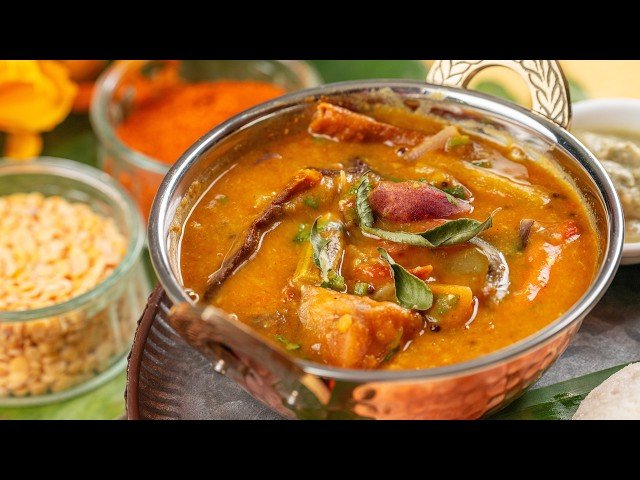
Now comes the part where everything comes together beautifully.
- Add the cooked dal to the pot of boiled vegetables.
- Pour in the tamarind extract and stir well.
- Add 2 to 3 teaspoons of sambar powder (adjust based on spice preference).
- Let the mixture come to a gentle simmer.
Allow the Sambar to cook uncovered on low heat for 10–15 minutes, stirring occasionally. The flavors of the dal, tamarind, and spices will begin to meld together, creating that signature South Indian aroma.
Adjust Consistency:
If the Sambar looks too thick, add a little hot water until it reaches a pourable, stew-like texture.
Step 5: Tempering – The Aromatic Finishing Touch
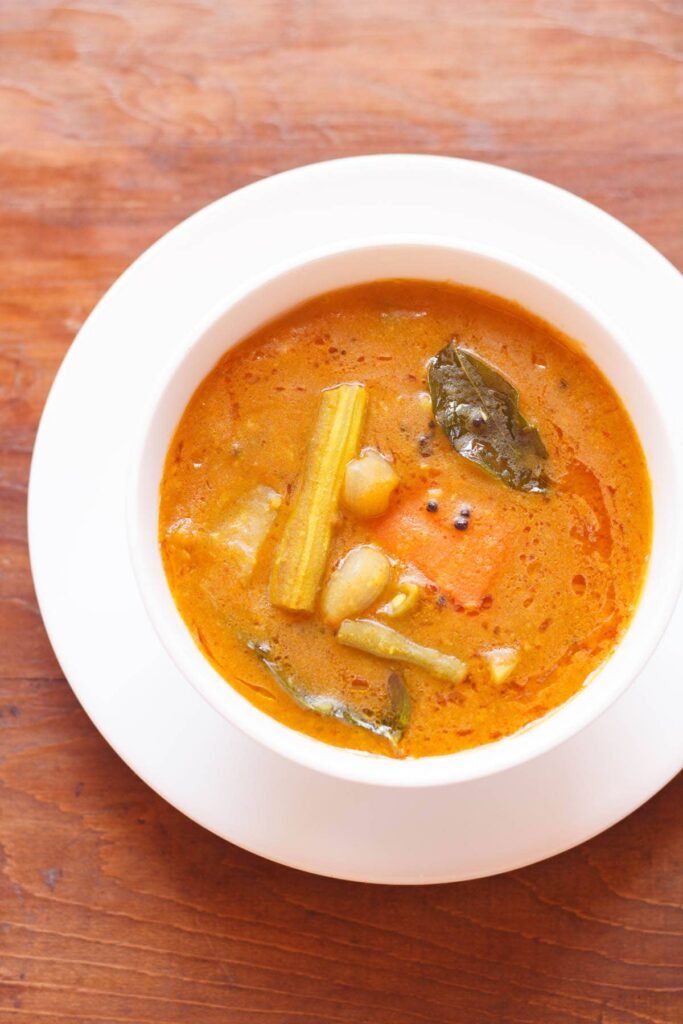
Tempering (or tadka) is what gives South Indian Sambar its irresistible aroma and final burst of flavor.
How to Temper Sambar:
- Heat 2 tablespoons of oil or ghee in a small pan.
- Add mustard seeds and let them pop.
- Add cumin seeds, dry red chilies, curry leaves, and a pinch of asafoetida (hing).
- Fry for just 20–30 seconds until fragrant — don’t let the spices burn!
- Immediately pour this sizzling tadka over the simmering Sambar and give it a quick stir.
That sound and smell — the sizzle of spices hitting the hot lentil stew — is the moment every South Indian cook waits for. It’s the magic that transforms a simple lentil soup into something divine.
Step 6: Garnish, Rest, and Serve
Your Sambar is now ready — but before serving, let it rest for 10–15 minutes off the heat. This resting time allows the flavors to deepen and balance beautifully.
Garnish with fresh coriander leaves and serve hot.
Serving Suggestions:
Sambar is incredibly versatile. Here’s how South Indians enjoy it across meals:
- With Idli: A classic breakfast combo — fluffy idlis soaked in hot Sambar and topped with ghee.
- With Dosa: Crisp dosas dipped in Sambar with coconut chutney on the side.
- With Vada: The beloved “Sambar Vada” — deep-fried lentil fritters soaking in spicy lentil soup.
- With Rice: The ultimate comfort meal — Sambar rice with papad, pickle, and curd.
Tips for Perfect South Indian Sambar
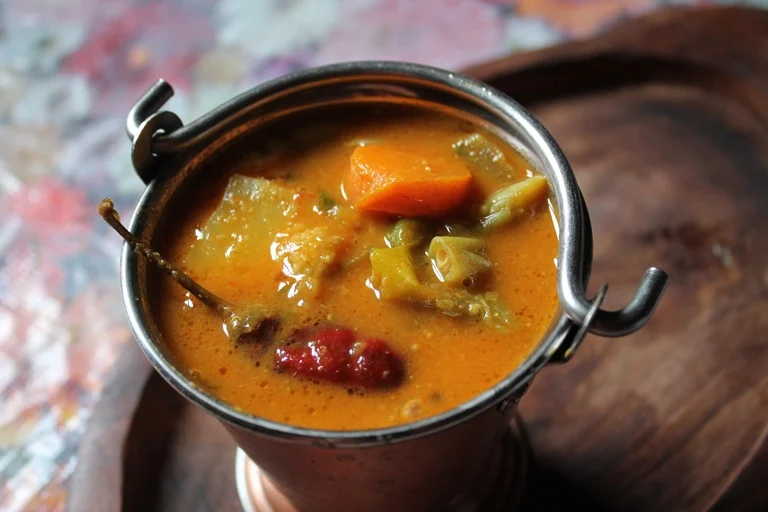
- Use toor dal: Though other lentils like moong or masoor can be used, authentic Sambar uses toor dal for its nutty flavor and creamy texture.
- Don’t skip tamarind: It’s what gives Sambar its characteristic tang. If you don’t have fresh tamarind, use a good-quality tamarind paste.
- Homemade sambar powder = best flavor. Store-bought is convenient, but homemade blends are fresher and more aromatic.
- Balance is key: The perfect Sambar should have a balance of spicy, tangy, and slightly sweet notes. You can add a pinch of jaggery if your tamarind is very sour.
- Use drumsticks if available: The unique flavor they impart is what makes authentic South Indian Sambar stand out.
- Add ghee at the end: A teaspoon of ghee just before serving enhances the richness and aroma.
Regional Variations of Sambar
Every state in South India has its own twist on this iconic dish.
- Tamil Nadu Sambar: Tangy and bold, often served with rice; includes small shallots or drumsticks.
- Kerala Sambar: Uses coconut and curry leaves for a rich, earthy flavor.
- Andhra Sambar: Spicier with more red chilies and tamarind.
- Karnataka Sambar: Slightly sweeter and thicker, often with jaggery and coconut.
You can try each version by tweaking the spices and vegetables — every region adds its own personality to the dish.
Why Homemade Sambar Tastes Better
Store-bought mixes or restaurant versions can’t match the warmth and aroma of homemade Sambar. When you roast your own spices, extract your tamarind fresh, and simmer everything slowly, you create layers of flavor that no instant packet can replicate.
Plus, Sambar is packed with plant-based protein, fiber, and antioxidants, making it one of the healthiest comfort foods in Indian cuisine.
Final Thoughts
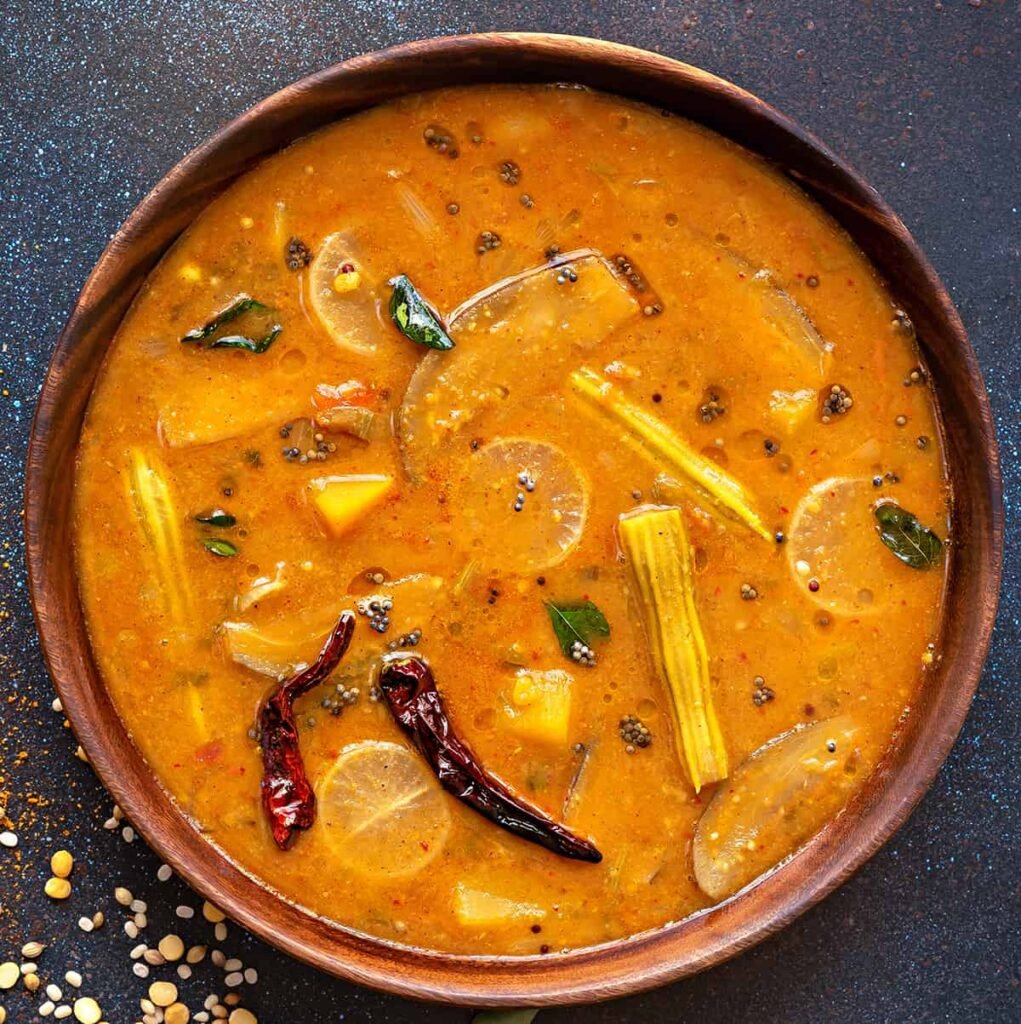
Making South Indian-style Sambar from scratch might seem elaborate, but once you understand the rhythm — cook the dal, boil the veggies, add tamarind and spices, and finish with tadka — it becomes second nature.
In just six simple steps, you can bring the flavors of a traditional South Indian kitchen to your table:
- Gather ingredients
- Cook the dal
- Prepare tamarind and veggies
- Combine everything
- Add tempering
- Rest and serve
The result? A bowl of Sambar that’s spicy, tangy, hearty, and deeply satisfying — perfect for any meal of the day.
So, next time you crave South Indian comfort food, skip the restaurant order. Instead, let your kitchen fill with the warm aroma of roasted spices and simmering tamarind — and serve up a pot of homemade Sambar made the authentic, soulful way.
